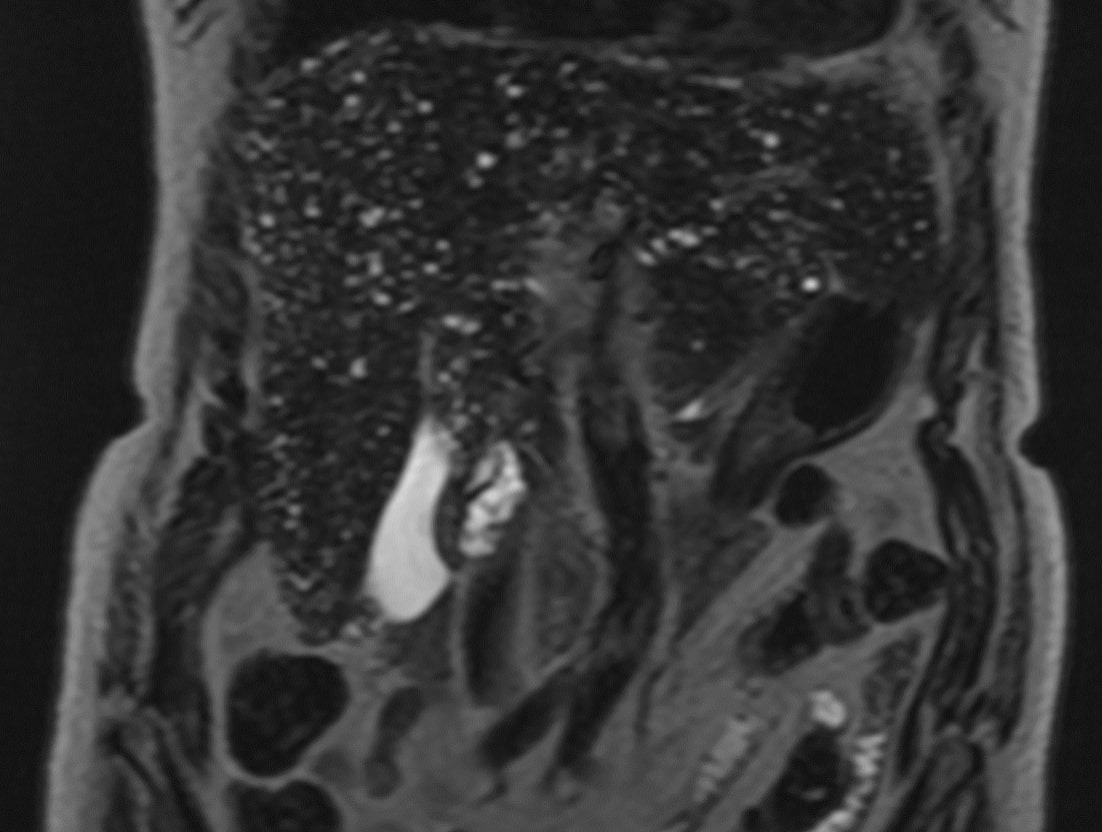Back


Poster Session B - Monday Morning
Category: Biliary/Pancreas
B0051 - Case Report: Sepsis Due to Klebsiella oxytoca Bacteremia and Jaundice Originating From Von Meyenburg Complex Superinfection
Monday, October 24, 2022
10:00 AM – 12:00 PM ET
Location: Crown Ballroom

Has Audio
- MF
Maya Fischman, MD
Hebrew University, Jerusalem
Haifa, Hefa, Israel
Presenting Author(s)
Maya Fischman, MD1, Amit Agarwal, MD2, David E. Loren, MD2
1Hebrew University, Jerusalem, Haifa, Hefa, Israel; 2Thomas Jefferson University Hospital, Philadelphia, PA
Introduction: Multiple biliary hamartomas (A.K.A. von Meyenburg Complexes, VMCs) are benign lesions found incidentally on hepatic imaging.1 Scarce reports describe complications in patients with VMCs, including abdominal pain, infection, portal hypertension, and cholangiocarcinoma.2–8 We present a case of Klebsiella oxytoca bacteremia leading to sepsis and jaundice, originating from a hamartoma superinfection.
Case Description/Methods: A 75-year-old female presented with malaise, jaundice and fever. She denied abdominal pain, vomiting or diarrhea. Past medical history was notable for alcoholic liver disease (non-cirrhotic), hepatic VMCs, and recently diagnosed lung adenocarcinoma. She was not taking any medications, supplements or vitamins and had not been abusing alcohol prior to her presentation.
On arrival, she was tachycardic, hypotensive, but afebrile. Laboratories were noted for WBC 15.9/mm3, ALP 260 IU/L, AST 88 IU/L, ALT 52 IU/L, total bilirubin 4.9mg/dL, direct 4.4mg/dL, creatinine 5.99mg/dL. Urinalysis ruled out pyuria and chest CT was without infection. Both abdominal US and CT were without biliary dilation or cholecystitis. Biliary hamartomas (VMCs) were unchanged from prior MRI. Blood cultures grew Klebsiella oxytoca. Clinical improvement, including improvement of serum bilirubin, was noted with 48 hours of cefepime. She was discharged in stable condition after four days of hospitalization.
Discussion: This case presents a gram-negative bacteremia of a known gastrointestinal tract/biliary pathogen, resulting in sepsis in a patient with VMCs.9 Potential sources of infection – including respiratory, urinary, hepatitis, cholangitis, and colitis – were excluded. Thus, superinfection of biliary hamartoma was the most likely cause for this patient’s presentation. In the medical literature, there have been 7 reports describing VMC superinfection as a cause of sepsis.2–4,10–12 This case adds to that body of literature. The diagnosis of VMC induced sepsis is one of exclusion after other possibilities have been investigated and is a rare entity that should be recognized.

Disclosures:
Maya Fischman, MD1, Amit Agarwal, MD2, David E. Loren, MD2. B0051 - Case Report: Sepsis Due to Klebsiella oxytoca Bacteremia and Jaundice Originating From Von Meyenburg Complex Superinfection, ACG 2022 Annual Scientific Meeting Abstracts. Charlotte, NC: American College of Gastroenterology.
1Hebrew University, Jerusalem, Haifa, Hefa, Israel; 2Thomas Jefferson University Hospital, Philadelphia, PA
Introduction: Multiple biliary hamartomas (A.K.A. von Meyenburg Complexes, VMCs) are benign lesions found incidentally on hepatic imaging.1 Scarce reports describe complications in patients with VMCs, including abdominal pain, infection, portal hypertension, and cholangiocarcinoma.2–8 We present a case of Klebsiella oxytoca bacteremia leading to sepsis and jaundice, originating from a hamartoma superinfection.
Case Description/Methods: A 75-year-old female presented with malaise, jaundice and fever. She denied abdominal pain, vomiting or diarrhea. Past medical history was notable for alcoholic liver disease (non-cirrhotic), hepatic VMCs, and recently diagnosed lung adenocarcinoma. She was not taking any medications, supplements or vitamins and had not been abusing alcohol prior to her presentation.
On arrival, she was tachycardic, hypotensive, but afebrile. Laboratories were noted for WBC 15.9/mm3, ALP 260 IU/L, AST 88 IU/L, ALT 52 IU/L, total bilirubin 4.9mg/dL, direct 4.4mg/dL, creatinine 5.99mg/dL. Urinalysis ruled out pyuria and chest CT was without infection. Both abdominal US and CT were without biliary dilation or cholecystitis. Biliary hamartomas (VMCs) were unchanged from prior MRI. Blood cultures grew Klebsiella oxytoca. Clinical improvement, including improvement of serum bilirubin, was noted with 48 hours of cefepime. She was discharged in stable condition after four days of hospitalization.
Discussion: This case presents a gram-negative bacteremia of a known gastrointestinal tract/biliary pathogen, resulting in sepsis in a patient with VMCs.9 Potential sources of infection – including respiratory, urinary, hepatitis, cholangitis, and colitis – were excluded. Thus, superinfection of biliary hamartoma was the most likely cause for this patient’s presentation. In the medical literature, there have been 7 reports describing VMC superinfection as a cause of sepsis.2–4,10–12 This case adds to that body of literature. The diagnosis of VMC induced sepsis is one of exclusion after other possibilities have been investigated and is a rare entity that should be recognized.

Figure: Image from patient’s prior MRI abdomen demonstrating innumerable biliary hamartomas consistent with von Meyenburg complex.
Disclosures:
Maya Fischman indicated no relevant financial relationships.
Amit Agarwal indicated no relevant financial relationships.
David Loren: Ambu – Consultant. Boston Scientific – Consultant. Olympus America – Consultant.
Maya Fischman, MD1, Amit Agarwal, MD2, David E. Loren, MD2. B0051 - Case Report: Sepsis Due to Klebsiella oxytoca Bacteremia and Jaundice Originating From Von Meyenburg Complex Superinfection, ACG 2022 Annual Scientific Meeting Abstracts. Charlotte, NC: American College of Gastroenterology.
